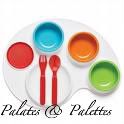
Mix enough water to cover the sugar. Heat it to dissolve slowly , stirring in between. Do not allow it to boil until completely dissolved. Once the sugar is biliong, do not stir more; If any crystals are formed at the sides of the pan, wipe it with a cloth dipped in warm water. Over stirring will affect the consistency of the sugar syrup while boiling . Boil the syrup in steady temperature
Sugar Syrup Consistencies:
Thin Syrup : Syrup gets a shine and the sugar is dissolved completely
Sticky Syrup: Dip your forefinger in the syrup after dipping it in cold water; When you rub thumb over fore finger it feels sticky.
Half thread consistency: String is formed when tested between thumb and forefinger ,but it will cut immediately.
One thread consistency: Thin string is formed when tested between thumb and forefinger.
Two thread consistency: When tested between fingers, two threads are formed.
2 1/2 - 3 thread consistency: when tested between thumb and forefinger, string appears in 2 or 3 places.
Gathered consistency: When a little syrup is poured over water, it settles down below the water. It can be gathered by hand.
Ball consistency: When syrup is poured over water , a smalll ball is formed when rolled with fingers, and should be hard enough.(Soft or hard depending upon the sweet)
Crack consistency: When a little syrup is poured over water, it becomes hard (No cracks to Brittle consistency)
Caramel consistency: Sugar syrup changes to a golden brown to a dark brown colour.
Read more...
 Thought this was too funny to pass up. And what better place to post it than here. Dont you love it? We happen to see one of Julia Child's French Chef programme and there she was deep frying an egg. Saw it and heard it for the first time. So thought of penning it down. She had a hot bath of olive oil and broke an egg into it as we do for egg curry. it looked something like a poached egg when it came out.
Thought this was too funny to pass up. And what better place to post it than here. Dont you love it? We happen to see one of Julia Child's French Chef programme and there she was deep frying an egg. Saw it and heard it for the first time. So thought of penning it down. She had a hot bath of olive oil and broke an egg into it as we do for egg curry. it looked something like a poached egg when it came out.
















